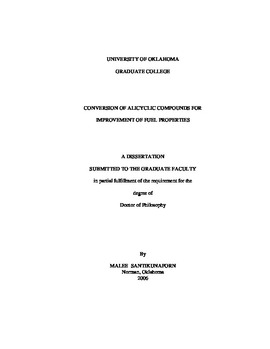| dc.contributor.advisor | Resasco, Daniel E., | en_US |
| dc.contributor.author | Santikunaporn, Malee. | en_US |
| dc.date.accessioned | 2013-08-16T12:20:18Z | |
| dc.date.available | 2013-08-16T12:20:18Z | |
| dc.date.issued | 2006 | en_US |
| dc.identifier.uri | https://hdl.handle.net/11244/1062 | |
| dc.description.abstract | The presence of Pt improves the production of ring-contraction and ring-opening products from tetralin due to hydrogenation of tetralin to decalin. In addition, the location of metal (Pt) affects the ratio of RC/RO on the decalin reaction. The results show that the ratio of RC/RO increases over Pt located on the inside of the zeolite structure resulting from the enhancement of the RC desorption rate. Inversely, the ratio of RC/RO decreases over catalysts with high acidity. | en_US |
| dc.description.abstract | An interesting possibility to remove (poly)aromatics is the opening of naphthenic rings derived from the saturation of aromatics (hydrogenation of aromatics) to produce molecules of higher cetane numbers (i.e., aromatics < naphthenics, i-paraffins < n-paraffins). In this contribution, the ring opening reaction of decalin over a series of HY and Pt/HY catalysts of varying acidity densities and the ring opening reaction of tetralin over different catalytic system configurations of Pt/SiO 2 and HY catalysts (Pt>>HY, HY>>Pt, and Pt+HY) under high hydrogen/feed molar ratio were investigated. Under these conditions, mainly ring-contraction and one-ring opening reactions take place over these catalysts. These products are important intermediates for high cetane number compounds. The results of this investigation show that HY zeolites with an optimum acidity can be effective catalysts for the ring-contraction and one-ring-opening of decalin in order to give high conversion, but slow deactivation. In addition, cis-decalin shows higher reactivity to ring-opening than trans-decalin. | en_US |
| dc.description.abstract | High demand for transport fuels (both diesel and gasoline) and the increasingly stringent environmental legislation associated with clean fuels have stimulated intense research for a development of new catalytic systems in order to produce high quality fuels with less negative environmental impact. Environmental regulations set limits in the content of (poly)aromatics in diesel and gasoline so that imposes a challenge to refiners who need to maintain high quality (cetane number for diesel and octane numbers for gasoline) while decreasing the (poly)aromatic content. | en_US |
| dc.description.abstract | Similarly to diesel fuel, aromatics in gasoline fuel have to decrease, even though they have a high octane number (ON). In this study, the ring-contraction reaction followed by selective ring-opening is proposed. The reaction of methylcyclohexane is investigated over various catalysts (HY, Pt and Ir/SiO2) and different catalytic system configurations with high hydrogen/feed molar ratio. (Abstract shortened by UMI.) | en_US |
| dc.format.extent | xxv, 227 leaves : | en_US |
| dc.subject | Hydrogenation. | en_US |
| dc.subject | Catalytic cracking. | en_US |
| dc.subject | Engineering, Chemical. | en_US |
| dc.subject | Alicyclic compounds. | en_US |
| dc.subject | Fuel. | en_US |
| dc.title | Conversion of alicyclic compounds for improvement of fuel properties. | en_US |
| dc.type | Thesis | en_US |
| dc.thesis.degree | D.Eng. | en_US |
| dc.thesis.degreeDiscipline | School of Chemical, Biological and Materials Engineering | en_US |
| dc.note | Source: Dissertation Abstracts International, Volume: 67-06, Section: B, page: 3294. | en_US |
| dc.note | Adviser: Daniel E. Resasco. | en_US |
| ou.identifier | (UMI)AAI3220226 | en_US |
| ou.group | College of Engineering::School of Chemical, Biological and Materials Engineering | |
